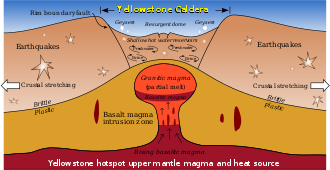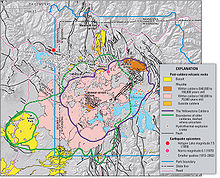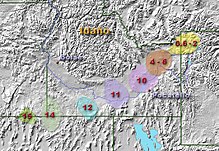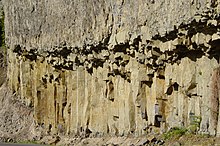Yellowstone (volcano)
The Yellowstone volcano is located under the national park of the same name in the United States . Its caldera was recognized as the crater of a gigantic volcano by Ferdinand V. Hayden as early as 1871 ; the geological connections between the hot spot , the Snake River Plain , the eruption history of the volcano and the activity that still exists today could only be determined over time. It is considered a super volcano .
Volcanism
A hot spot , i.e. a zone where hot mantle material rises under the earth's crust , is the origin of the 17 million year old volcanic system. The North American plate has moved over this relatively firmly anchored hot spot, with the lithosphere being greatly altered by tectonic and magmatic processes. At the same time, the more than 700 km long Yellowstone Snake River volcanic system was formed, the most visible traces of which are formed by several calderas . Some of their traces can be followed very clearly.
The jacket plume of hot spots is sufficient to recent data from the 2015 to the uppermost surface layer at a depth of about 63 km away. Its heat leads to a partial melting of the basic lower earth crust above the Moho , which is to be set at ≈45 km depth. This deep magma chamber is determined to have a volume of ≈46,000 km³ and was first detected in 2015. It is connected to the previously known upper magma chamber by heat currents. It could be determined by new evaluations of seismic data to a depth of a maximum of 20 km and an approximate volume of ≈10,000 km³. Due to its location in the upper crust of the earth, it is rocky and feeds the volcanism of the surface. The lower magma chamber has a proportion of around 2% molten material, that of the upper magma chamber can be assumed to be around 9%.
The mantle Plume created a bulge 400 km wide and 500 m high on the Yellowstone Plateau. In recent years, geodetic measuring devices have also been used to measure deformations and subsidence, i.e. H. Arching and sinking in the volcanic system closely followed. On average, there are movements of 2 cm per year. In the years 2004–2009, however, an accelerated bulging movement could be ascertained, which was interpreted as fresh magma intrusion into the horizontal passages above the actual magma chamber at a depth of 10 km. Volcanism causes up to 2000 mostly weak earthquakes in the region every year.
Recorded outbreaks so far
The Yellowstone Hot Spot
The continental plate sliding over the hot spot has revealed traces of volcanic activity over millions of years, in this case a chain of calderas on the North American continent. The magma chamber is around 60 km long, 35 km wide, 8-10 km thick and heats underground water resources, which, like the Old Faithful , sometimes come to the surface as geysers .
Geological studies show that the Yellowstone hotspot has been active for 17 million years and that the earth's surface has shifted during this period as a result of plate tectonics so that the hotspot apparently moved around 700 km from today's northern Nevada via southern Idaho to its present location is. He created the bedrock of the Snake River Plain and left a basaltic - rhyolitic magma pocket, which temporarily caused an uplift of 15 cm in the area of the Snake River.
A study from 2020 points to two super-eruptions from the younger Miocene , 8.99 and 8.72 million years ago, with an ejection volume of around 1700 km³ and 2800 km³ respectively.
The caldera-forming eruptions
The last three of the very large eruptions of the Yellowstone hotspot took place in today's national park or in its immediate vicinity 2.1 million ( Huckleberry Ridge eruption ), 1.3 million ( Mesa Falls eruption ) and 0.64 million years ago ( Lava Creek eruption ) took place.
The first of the three mentioned eruptions was strongest around 2.1 million years ago. A caldera of approx. 80 × 50 km was created. Around 2500 km³ of material was thrown out. However, the latest studies indicate that the amounts of material ejected in this so-called Huckleberry Ridge eruption are not due to one, but to at least two, if not more, eruptions between which were 4000 years. Klemetti quotes the article and mentions a distribution over even three phases, which would have produced 1340 km³, 820 km³ and 290 km³ respectively - still very considerable amounts, but not as much as scientists initially assumed.
The second eruption around 1.3 million years ago was the smallest of the three, in which 280 km³ of material were ejected.
The third caldera-forming series of eruptions around 640,000 years ago created an overlapping total caldera 80 km long and 55 km wide. The eruption, like the previous one, was triggered by the activation of magmas in magma chambers close to the surface. In addition to enormous amounts of ash, the traces of which reach as far as California , it produced numerous pyroclastic flows, among other things . The resulting ignimbrites with a volume of around 1000 km³ are called Lava Creek Tuff and can be seen in the cliffs of Madison Canyon.
Due to the strength of these and later eruptions, the Yellowstone volcano is counted as a super volcano .
Later outbreaks in the system
After these major eruptions, the volcano remained active, but subsequent eruptions were nowhere near as catastrophic.
Tuff deposits from two later explosive eruptions 170,000 years ago (Bluff Point Tuff) and 140,000 years ago (Cold Mountain Creek Tuff) show an ejected volume of 50 and 10 km³, respectively, which makes up the strength 6 on the volcanic explosion index .
Further effusive rhyolitic lava eruptions in the period from 180,000 to 70,000 years ago filled the caldera almost completely with a total volume of 600 km³ and formed today's Yellowstone Plateau.
In the Holocene there were smaller eruptions about 9,400 years ago at Turbid Lake, 8,050 years ago at Elliot's Crater, 5,050 years ago at Duck Lake and the Evil Twin Craters, and most recently 3,350 years ago at Indian Pond Crater. These were exclusively local steam explosions .
Course of possible eruptions in the future
Even today, Yellowstone still has a large magma chamber, so that a similarly large eruption still seems possible at some point. However, the US Geological Survey (USGS), the geological investigation office responsible for monitoring the system in the United States, does not anticipate significant eruptions in the system in the near future. Rather, it is expected that the high-temperature areas , phreatic explosions and moderate to strong earthquake activity will continue to act.
Since 1995 a new pattern of seismic activity has appeared. The USGS reported that the northern rim of the crater rose while the base fell. These opposing movements increased steadily, but came to a standstill again in 2003. Around the turn of the year 2008/2009 an accumulation of small and very small earthquakes was observed, but by March 2009 the seismic activity had returned to its long-term average level.
These movements are believed to be caused by molten basalt flowing in the underground magma channels. In the 1990s, these were presumably amplified when a magma surge from the upper mantle flowed into the Yellowstone volcanic system. Since only a small amount of magma apparently flowed off, the pressure increased, creating new rock fissures, which in turn created a better connection to the deeper magma reservoir. The movements led to increased geothermal activity in the area.
According to the USGS scientists, such phases of “thermal unrest” have already taken place repeatedly, so far without any consequences in the recent past.
Films / documentaries
2005 was BBC under the title Supervolcano (dt. Supervolcano ) a mixture of docudrama and fictional disaster movie turn, dealing with an outbreak of Yellowstone.
On November 12, 2009, Roland Emmerich's film " 2012 " was released, which, among other things, deals with the eruption of the supervolcano.
In the US documentary series Doomsday - Countdown to the Apocalypse , Episode 06 Mega Eruption from 2016, the scenario of a Yellowstone eruption is thematized as one of the greatest catastrophes of mankind.
Web links
- Yellowstone Volcano Observatory (English)
- USGS: History and Geology (history and geology of Yellowstone briefly summarized, popular science) (English)
- Vic Camp: Yellowstone Caldera, Wyoming. Calderas. How volcanoes work , San Diego State University
- Robert L. Christiansen, Jacob B. Lowenstern, Robert B. Smith, Henry Heasler, Lisa A. Morgan, Manuel Nathenson, Larry G. Mastin, LJ Patrick Muffler, Joel E. Robinson: Preliminary Assessment of Volcanic and Hydrothermal Hazards in Yellowstone National Park and Vicinity. (PDF; 8.7 MB) Open-file Report 2007-1071. In: usgs.gov. US Geological Survey , 2007, accessed March 1, 2016 .
literature
- Ilya N. Bindeman, Bin Fu, Noriko T. Kita, John W. Valley: Origin and Evolution of Silicic Magmatism at Yellowstone Based on Ion Microprobe Analysis of Isotopically Zoned Zircons . In: Journal of Petrology . tape 49 , no. 1 , January 1, 2008, p. 163-193 , doi : 10.1093 / petrology / egm075 ( oxfordjournals.org ).
- Katrina R. DeNosaquo, Robert B. Smith, Anthony R. Lowry: Density and lithospheric strength models of the Yellowstone – Snake River Plain volcanic system from gravity and heat flow data . In: Journal of Volcanology and Geothermal Research . tape 188 , no. 1–3 , November 20, 2009, pp. 108-127 , doi : 10.1016 / j.jvolgeores.2009.08.006 ( sciencedirect.com ).
Individual evidence
- ^ A b c d Robert B. Smith, Lawrence W. Braile: Crustal Structure and Evolution of an Explosive Silicic Volcanic System at Yellowstone National Park . Geology of Yellowstone Park Area; 33rd Annual Field Conference Guidebook, 1982, pp. 233-250 Abstract; Retrieved September 22, 2012
- ↑ Robert B. Smith, Michael Jordan, Bernhard Steinberger, Christine M. Puskas, Jamie Farrell, Gregory P. Waite, Stephan Husen, Wu-Lung Chang, Richard O'Connell: Geodynamics of the Yellowstone hotspot and mantle plume: Seismic and GPS imaging, kinematics, and mantle flow . In: Journal of Volcanology and Geothermal Research . tape 188 , no. 1–3 , November 20, 2009, pp. 26–56 , doi : 10.1016 / j.jvolgeores.2009.08.020 ( uusatrg.utah.edu [PDF; 17.4 MB ]).
- ↑ Hsin-Hua Huang, Fan-Chi Lin, et al .: The Yellowstone magmatic system from the mantle plume to the upper crust . In: Science , online pre-publication on April 23, 2015, doi: 10.1126 / science.aaa5648
- ↑ Yellowstone in the Global Volcanism Program of the Smithsonian Institution (English)
- ↑ Mark Anders: Yellowstone hotspot track. In: columbia.edu. Retrieved March 1, 2016 .
- ↑ Thomas R. Knott, Michael J. Branney, Marc K. Reichow, David R. Finn, Simon Tapster, Robert S. Coe: Discovery of two new super-eruptions from the Yellowstone hotspot track (USA): Is the Yellowstone hotspot waning ? . (PDF) In: Geology . June 2020. doi : 10.1130 / G47384.1 .
- ↑ Yellowstone Caldera. Yellowstone hotspot and volcanism. In: Stromboli online. August 23, 2007, accessed March 1, 2016 .
- ↑ Ben S. Ellis, Darren F. Mark et al. a .: Temporal dissection of the Huckleberry Ridge Tuff using the 40Ar / 39Ar dating technique. In: Quaternary Geochronology. 9, 2012, pp. 34-41, doi: 10.1016 / j.quageo.2012.01.006 .
- ↑ Erik Klemetti: Giant Eruptions from Yellowstone Caldera May Have Taken Millennia. In: wired.com. Wired , March 5, 2012, accessed March 1, 2016 .
- ^ Three Volcanic Cycles of Yellowstone. In: usgs.gov. US Geological Survey , accessed March 1, 2016 .
- ^ A b Jacob B. Lowenstern, Robert L. Christiansen, Robert B. Smith, Lisa A. Morgan, Henry Heasler: Steam Explosions, Quakes, and Volcanic Eruptions - What's in Yellowstone's Future? USGS Fact Sheet 2005-3024. In: usgs.gov. US Geological Survey , accessed March 1, 2016 .
- ↑ Guillaume Girard, John Stix: Future volcanism at Yellowstone caldera: Insights from geochemistry of young volcanic units and monitoring of volcanic unrest . In: GSA Today . tape 22 , no. 9 , 2012, p. 4–10 , doi : 10.1130 / GSATG143A.1 ( geosociety.org [PDF; 1.5 MB ]).
- ↑ Summary of Eruption History. In: usgs.gov. US Geological Survey , accessed March 1, 2016 .
- ↑ Yellowstone - Eruptive History in GVP; accessed: September 22, 2012
- ↑ Yellowstone Lake Earthquake Swarm Summary. In: usgs.gov. US Geological Survey , January 2009, accessed March 1, 2016 .
Coordinates: 44 ° 24 ′ N , 110 ° 42 ′ W




